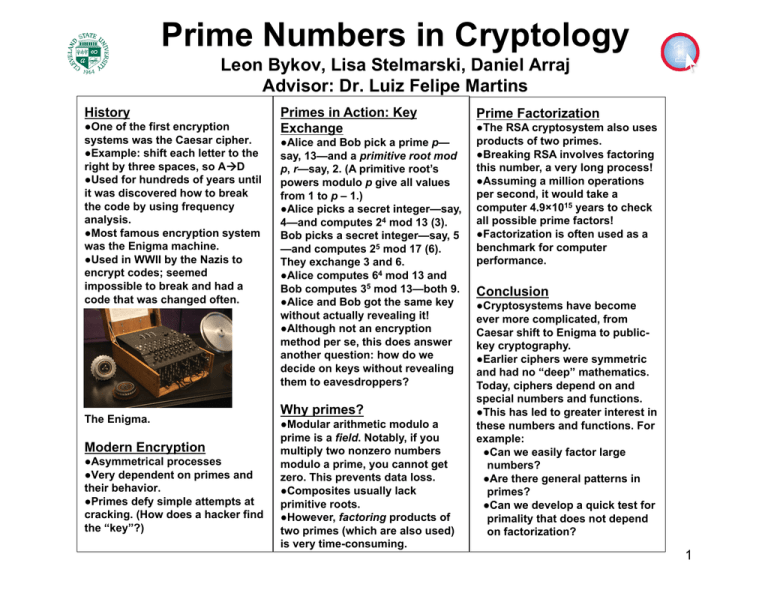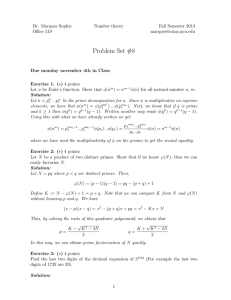Prime Numbers in Cryptology Leon Bykov, Lisa Stelmarski, Daniel Arraj History
advertisement

Prime Numbers in Cryptology Leon Bykov, Lisa Stelmarski, Daniel Arraj Advisor: Dr. Luiz Felipe Martins History ● One of the first encryption systems was the Caesar cipher. ● Example: shift each letter to the right by three spaces, so AàD ● Used for hundreds of years until it was discovered how to break the code by using frequency analysis. ● Most famous encryption system was the Enigma machine. ● Used in WWII by the Nazis to encrypt codes; seemed impossible to break and had a code that was changed often. The Enigma. Modern Encryption ● Asymmetrical processes ● Very dependent on primes and their behavior. ● Primes defy simple attempts at cracking. (How does a hacker find the “key”?) Primes in Action: Key Exchange ● Alice and Bob pick a prime p— say, 13—and a primitive root mod p, r—say, 2. (A primitive root’s powers modulo p give all values from 1 to p – 1.) ● Alice picks a secret integer—say, 4—and computes 24 mod 13 (3). Bob picks a secret integer—say, 5 —and computes 25 mod 17 (6). They exchange 3 and 6. ● Alice computes 64 mod 13 and Bob computes 35 mod 13—both 9. ● Alice and Bob got the same key without actually revealing it! ● Although not an encryption method per se, this does answer another question: how do we decide on keys without revealing them to eavesdroppers? Why primes? ● Modular arithmetic modulo a prime is a field. Notably, if you multiply two nonzero numbers modulo a prime, you cannot get zero. This prevents data loss. ● Composites usually lack primitive roots. ● However, factoring products of two primes (which are also used) is very time-consuming. Prime Factorization ● The RSA cryptosystem also uses products of two primes. ● Breaking RSA involves factoring this number, a very long process! ● Assuming a million operations per second, it would take a computer 4.9×1015 years to check all possible prime factors! ● Factorization is often used as a benchmark for computer performance. Conclusion ● Cryptosystems have become ever more complicated, from Caesar shift to Enigma to publickey cryptography. ● Earlier ciphers were symmetric and had no “deep” mathematics. Today, ciphers depend on and special numbers and functions. ● This has led to greater interest in these numbers and functions. For example: ● Can we easily factor large numbers? ● Are there general patterns in primes? ● Can we develop a quick test for primality that does not depend on factorization? 1







